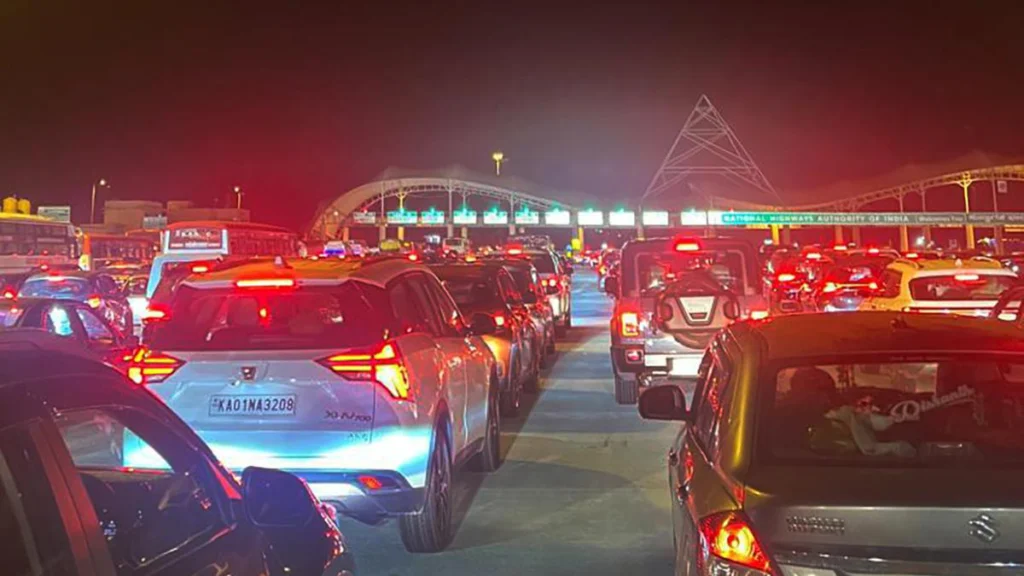Traffic chaos near toll plazas ruins smooth Bengaluru–Mysuru highway experience

Traffic Woes Return on Bengaluru–Mysuru Highway: Commuters Demand Urgent Fixes from NHAI
What was once celebrated as a modern, time-saving expressway has now turned into a source of aggravation for thousands of motorists. The access-controlled Bengaluru–Mysuru highway, envisioned as a game-changer for commuters, witnessed massive traffic snarls during the recent long festival weekend. Particularly troubling were the scenes at Sheshagiri Halli and Kaniminike toll plazas, where congestion reached frustrating levels and left commuters stranded for hours.
For many who had planned quick getaways or family reunions for the holidays, the weekend travel turned into a test of patience — and a reminder that smart infrastructure needs smarter execution.
From Promise to Problem: What Went Wrong?
Inaugurated with much fanfare, the Bengaluru–Mysuru expressway was designed to cut down travel time from over three hours to just 90 minutes. The project, developed and managed by the National Highways Authority of India (NHAI), featured wide lanes, elevated corridors, and Fastag-enabled toll booths aimed at streamlining movement.
However, the weekend’s chaos revealed glaring inefficiencies in the system. Motorists reported long queues at toll plazas, with vehicles stretching for kilometres and barely moving. Several drivers noted that Fastag sensors malfunctioned, causing delays even for those who had recharged and linked their Fastags properly.
“The whole point of this highway was to save time,” said Vikram S, a Bengaluru-based tech worker who was traveling to Mandya. “Instead, I spent over two hours just crossing one toll plaza. What’s the point of calling it an expressway if we’re crawling like city traffic?”
Toll Plazas Become Bottlenecks
The toll booths at Sheshagiri Halli and Kaniminike turned into major choke points. Despite having multiple lanes, officials were unable to manage the surge in vehicles effectively. In some cases, drivers reported manual scanning of Fastags, defeating the purpose of a seamless tolling experience.
Several Fastag users found their tags weren’t getting detected, forcing toll staff to intervene manually. This not only slowed down the process but also led to confusion, verbal arguments, and longer wait times.
Adding to the frustration was the lack of contingency planning. With vehicles piling up, there was no visible effort to open additional lanes or let traffic pass temporarily to ease the gridlock.
A Festival Weekend Gone Wrong
The long weekend brought a surge of vehicles, with thousands heading toward tourist destinations like Mysuru, Coorg, and Bandipur. Many families had scheduled trips well in advance, expecting the expressway to offer a stress-free journey.
Instead, social media flooded with images and videos of bumper-to-bumper traffic, people stepping out of their cars in frustration, and even some vehicles breaking down after prolonged idling.
Children, elderly passengers, and patients faced the brunt of the delay, with some reportedly missing appointments, train connections, or festival events due to the hold-up.
Commuters Demand Accountability
Angry commuters have now turned to social media and citizen forums, tagging NHAI and the Ministry of Road Transport and Highways. The complaints point to poor toll management, faulty infrastructure, and the lack of real-time updates to alert travelers about congestion.
“Modern highways need more than just tarmac and toll booths,” wrote one user on X (formerly Twitter). “They need tech, planning, and people who can manage traffic under pressure. NHAI needs to fix this before it becomes a weekly nightmare.”
Another frustrated user shared: “Why can’t they have an emergency protocol? Just open the gates if things are this bad. Revenue is important, but human experience matters too.”
What Can Be Done?
Experts and commuters alike are now urging NHAI to take the following steps:
- Fix and calibrate Fastag sensors to ensure 100% detection, reducing the need for manual intervention.
- Deploy trained personnel to manage traffic surges during weekends and public holidays.
- Open additional lanes or gates temporarily during peak hours to avoid pile-ups.
- Send real-time traffic updates through mobile apps and variable message signs to inform motorists about upcoming delays.
- Introduce dynamic tolling or time-slots to spread out traffic during long weekends.
Transportation expert Dr. A. Kumar, who has worked on several national highway projects, said, “Access-controlled highways need access-controlled thinking. You can’t apply old-school toll management to modern traffic volumes. It’s time for NHAI to evolve.”
NHAI Yet to Issue a Statement
As of now, NHAI has not issued an official response regarding the weekend congestion. However, sources say an internal review may be underway, and officials have taken note of the rising public criticism.
With the holiday season approaching and more long weekends on the horizon, commuters are hoping for quick action and long-term solutions.
A Vision That Needs Reinforcement
The Bengaluru–Mysuru expressway was meant to be a symbol of India’s growing road infrastructure — fast, efficient, and commuter-friendly. But this weekend’s events show that execution hasn’t caught up with vision.
Until toll systems improve and contingency plans kick in during high-traffic periods, commuters will continue to suffer the irony of being stuck on a highway built for speed.






